Don't wanna be here? Send us removal request.
Text
Color of Change
youtube
According to their website, “Color of Change is the nation’s largest online racial justice organization.” The non-profit organization is dedicated to shedding light on injustices and racial aggressions against Black people around the world. The organization effectively responds to those injustices by influencing those in power to make changes, such as those in government and large corporations. Color of Change is just one of many organizations working across the world to take down the powers that keep racism and injustice in place.
Although Color of Change was only founded in 2005, its mission and activism can be felt throughout history within so many others that fought for Black justice. During the Great depression, as unemployment rates grew and money grew scarce, African Americans were at the bottom of the totem pole when it came to jobs. Forced to choose between starvation and survival, many African Americans were forced to turn to public relief during the economic crisis. When the National Recovery Administration failed to eliminate discrimination in the workplace for Black workers, activists fought for justice. John L. Lewis fought for Black workers to be included in unions and demanded equal pay. Another group similar to Color of Change, called the Committee for Industrial Organization, organized massive campaigns across the country urging “racial equality in Union membership.” (Takaki, 1993, p. 334) The United Auto Workers union was finally recognized and won wage increases in 1941. Takaki states, “While these achievements did not mean the end of racism among white workers, they demonstrated that interracial labor solidarity was essential.” (Takaki, 1993, p. 335) These same sentiments can be seen through the activism Color of Change brings forth with every new movement.
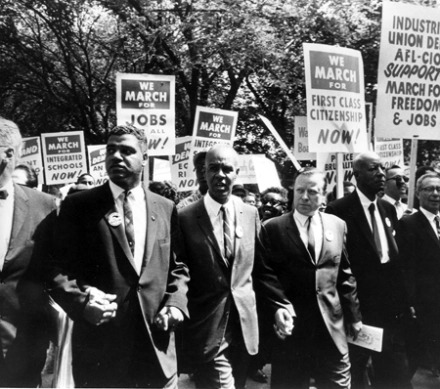
(Image Source: https://todayinlaborhistory.wordpress.com/tag/cio/)
As time continued to move forward, so did the fight for equality for Black Americans. Closer to home, in Milwaukee, during the Civil Rights Movement, the March on Milwaukee took place. On August 28th, 1967, “over one hundred members of the Milwaukee Youth Council of the NAACP” marched from their headquarters on north 15th Street, across the 16th Street Viaduct, south to Kosciuszko Park on Lincoln Ave in the fight for fair and open housing, regardless of race (Rozga, 2007, p. 29). Rioters in opposition of open housing harassed the marches on the southside of the viaduct, the bridge connecting the predominantly African American northside to the White southside. Color of Change organizes similar movements and protests for modern issues such as ending prison profiteering, hair policies for Black employees in corporations, reliable access to clean water in predominantly Black communities, ending anti-Black narratives in the media, etc.

(Image Source: https://milwaukeenns.org/open-housing/open-housing-marches-placed-spotlight-on-racial-discrimination-segregation.php)
In her article White Privilege: Unpacking the Invisible Knapsack, Peggy McIntosh stated, “simply disapproving of the systems that hold systemic racism in power won’t be enough to change them.” (McIntosh, 2010). Color of Change has initiated reformations across many entities including local criminal justice systems, tech corporations, media, and even Fortune 500 companies. The platform Color of Change has now, in modern times, is larger than many had in the past. Color of Change arms the most vulnerable groups with the means and voice to make significant strides forward in the name of equality.

(Image Source: https://airlift.fund/news/2018/3/19/color-of-change-named-2-on-fast-companys-most-innovative-non-profits)
References
“About Color of Change.” Color of Change, colorofchange.org/about/. Accessed 2 May 2024.
Margaret Rozga. “March on Milwaukee.” The Wisconsin Magazine of History, vol. 90, no. 4, 2007, pp. 28–39. JSTOR, http://www.jstor.org/stable/4637228. Accessed 2 May 2024.
McIntosh, Peggy. “‘White Privilege: Unpacking the Invisible Knapsack��� and ‘Some Notes for Facilitators.’” National SEED Project, 2010, www.nationalseedproject.org/key-seed-texts/white-privilege-unpacking-the-invisible-knapsack.
Takaki, Ronald. “To ‘the Land of Hope’: Blacks in the Urban North.” A Different Mirror: A History of Multicultural America, Little, Brown and Company, 1993, pp. 311–335.
0 notes
Text
The Help
The Help (2011) is a movie directed by Tate Taylor. The movie is based in the 1960’s in the American South during the Civil Rights Movement. Skeeter, an aspiring author, returns to her hometown of Jackson, MS. She begins to author a novel based on the point of view of “the help” – a term used for African American women hired as housekeepers by white families during the time. Secretly Skeeter collaborates with African American housekeepers, Aibileen and Minny, to author stories about their experiences.
While laws were changing, during the Civil Rights Movement in the 1960’s, there were still racial aggressions towards Black people, especially in the American South. We see this in an earlier scene in the movie when Hilly, a white woman, refuses to use the bathroom at her friend, Mrs. Leefolt’s, home because her African American housekeeper, Aibileen, uses the guest bathroom as well. Hilly installed a separate bathroom outside of her own home for her housekeeper Minnie to use and encourages Mrs. Leefolt to do the same, claiming that African Americans carry different diseases than white people. She even goes as far as to mark the toilet paper in her own bathrooms with pencil to see if her housekeeper, Minny, is using their indoor restrooms and tries to force her to go to the outside restroom during a severe storm. This ties into Gregory Jay’s article “Who Invented White People?” Jay states, “… Americans faced the fact that changing the laws did not change the feelings and beliefs of individuals, black or white. Beyond the abstract words of law and legislation, real people continued to carry with them the history of racism, whether as victims of its horrors or as beneficiaries of its privileges.”
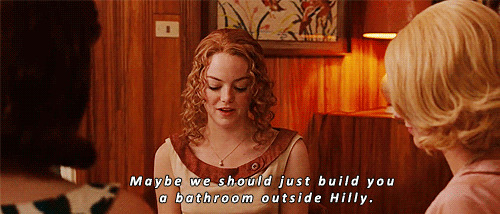
Throughout the movie we can also see the socioeconomic disparities when it comes to race. The fact that African American housekeepers mostly lived in the same lower-class neighborhood in Jackson, all catching the bus in the morning to take them to the upper-class, white neighborhoods where they worked. There is also a point where we see Minny preparing her eldest daughter for her first day of work as a housekeeper. Her daughter was pulled out of school to support the family financially.
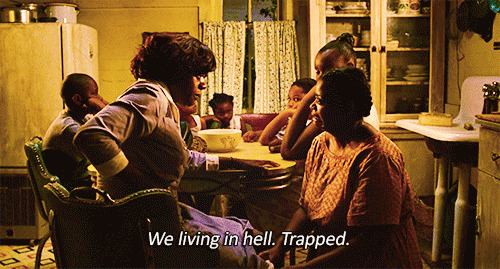
Although The Help focuses on race, there is quite a few instances of gender bias as well. We can see this clearly with Skeeter. When she comes home and applies to be a columnist at The Jackson Journal, she is given the Miss Myrna column to run – a column focused on housekeeping tips and tricks which is very fitting for what was considered to be a woman’s role during the time. In addition, Skeeter hasn’t had much experience in dating unlike her social peers who are already married with children. Throughout the movie there are subtle reminders that due to Skeeter’s choice to have a career, how she dresses/styles her hair, and her opinions make her an unlikely prospect for marriage. Skeeter seemingly has similarities with Peggy McIntosh, the author of “White Privilege: Unpacking the Invisible Knapsack” in which McIntosh references the understanding of white privilege by comparing it to her experience amongst men who do not realize their advantages. It seems as if Skeeter’s rejection of conformity to a 1960s homemaker and the fact that she was extremely close to her own family’s housekeeper, Constantine, allows her to see the unjust treatment of Black women of the time. Like McIntosh references in her article, it’s simply not enough to disapprove of the powers that keep systemic racism in place, people must work to dismantle them. Skeeter embodies the change she wishes to see by giving a voice to those whose voices have been suppressed by authoring the book The Help.
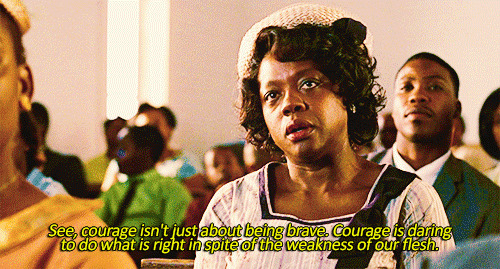
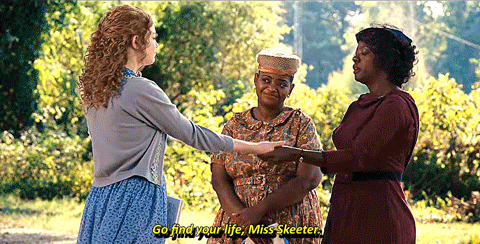
References
IMDb. “The Help (2011) - Plot - IMDb.” Www.imdb.com, www.imdb.com/title/tt1454029/plotsummary/.
Jay, Gregory. “Who Invented White People?” The Thomson Reader: Conversations in Context, by Robert P. Yagelski, Wadsworth Publishing, Jan. 2006, pp. 96–102.
McIntosh, Peggy. “‘White Privilege: Unpacking the Invisible Knapsack’ and ‘Some Notes for Facilitators.’” National SEED Project, 2010, www.nationalseedproject.org/key-seed-texts/white-privilege-unpacking-the-invisible-knapsack.
0 notes
Text
Jane the Virgin

Jane the Virgin is a television series that ran from 2014 – 2019 on The CW television network. The show follows a young woman in her twenties (Jane Villanueva) who accidentally gets artificially inseminated and becomes pregnant although she is a virgin. The show then follows a storyline full of plots, twists, and turns, as Jane navigates different challenges regarding coming of age, motherhood, love, religion, marriage, sex, ethnicity, culture, etc. The show uses a technique popular in Latin telenovelas by using cliché plot twists to emphasize drama, in a comedic manner.
One of the main, and up-front components of the show, is the way it intentionally and unapologetically bombards viewers with Hispanic culture. Jane’s grandmother, Alba, immigrated to the United States from Venezuela with her late husband and they built a life for themselves. From the cultural dishes, such as arepas, Calle Ocho in Miami, Catholicism, to telenovelas, the list goes on and on. One of the more profound elements of the show is the fact that Alba almost exclusively speaks Spanish from the very first episode to the very last. There are minimal scenes where Alba speaks English. To have one of the main characters only speak Spanish while the series dominated an American television network, was monumental.
Jane the Virgin finds a way to strategically incorporate social challenges and brings awareness to various socioeconomic issues. We see this clearly throughout Season 2 where Jane and her artificial inseminator, Rafael, clash when it comes to wealth and class. Jane, who grew up more modestly, has concerns about how their son’s character could be impacted by his inheritance and Rafael’s wealth. They face head on challenges with paying for extracurricular activities, schooling, inheritance, etc. It has parallels to Richard Dyer’s, “On the Matter of Whiteness” and Peggy McIntosh’s “White Privilege: Unpacking the Invisible Knapsack” but instead of whiteness versus non-whiteness, it’s a clash of class. We see this wealth privilege on full display in Season 1, Episode 17, when Rafael decides to follow through with a large hotel party after Calle Ocho without the proper event permits. The police officers show up asking about the permits and Rafael hints towards a bribe where the police officers could overlook this issue, which in the end does not work out well for him or his hotel and resulted in fines and the loss of the hotel’s liquor license (Snyder Urman et al. Chapter 17). The idea that Rafael could avoid the consequences of an illegal act because of money, is similar to when McIntosh referenced how people are comfortable in their oppressiveness without even realizing that they are doing it. In addition, in Season 4, we see Jane and Rafael using her parent’s address to get their son enrolled to a public school in a better district. This is a modern-day representation of educational segregation. Throughout history we see schools segregated by race and in today’s world we see profound differences in school funding for different districts, with most disparities negatively affecting low-income families in urban neighborhoods.

The series also shows a modern-day version of immigration to America, which we touched on what immigration looked like in America from 1700-1900. Viewers get to see Alba go through immigration challenges, such as gathering the courage to apply for a green card (Snyder Urman et al. Chapter 30) and finally obtaining citizenship (Snyder Urman et al. Chapter 81).

Alba also witnesses a racist aggression towards a Spanish-speaking shopper in the Marbella gift store, where a white woman approached her and told her, “This is America. You should learn how to speak English,” (Snyder Urman et al. Chapter 61). Although this type of aggression became more commonly filmed in the real world in the mid to late 2010’s, we can see this throughout history. Karin Higa’s “Toyo Miyatake and ‘Our World’” fully illustrates how Japanese Americans were portrayed as having “hyper-Americanism” within the internment camps almost as if they were trying to prove how American they were. It can spark a deeper conversation around what it exactly means to be an American. These are just a few examples of how Jane the Virgin sheds light on current issues and addresses them, head on!

References
Fusco, Coco, Brian Wallis, and Karin Higa. “Toyo Miyatake and ‘Our World.’” Only Skin Deep: Changing Visions of the American Self, International Center of Photography in Association with Harry N. Abrams, Inc., Publishers, New York, New York, 2003, pp. 335–343.
Fusco, Coco, Brian Wallis, and Richard Dyer. “On the Matter of Whiteness.” Only Skin Deep: Changing Visions of the American Self, International Center of Photography in Association with Harry N. Abrams, Inc., Publishers, New York, New York, 2003, pp. 301–311.
McIntosh, Peggy. “‘White Privilege: Unpacking the Invisible Knapsack’ and ‘Some Notes for Facilitators.’” National SEED Project, 2010, www.nationalseedproject.org/key-seed-texts/white-privilege-unpacking-the-invisible-knapsack.
Snyder Urman, Jennie, Carolina Rivera, and Paul Sciarrotta. “Chapter 30.” Jane the Virgin, season 2, episode 8, The CW, 14 Dec. 2015.
Snyder Urman, Jennie, Jessica O’Toole, and Amy Rardin. “Chapter 17.” Jane the Virgin, season 1, episode 17, The CW, 6 Apr. 2015.
Snyder Urman, Jennie, Paul Sciarrotta, and Carolina Rivera. “Chapter 61.” Jane the Virgin, season 3, episode 17, The CW, 1 May 2017.
Snyder Urman, Jennie, Paul Sciarrotta, and Chantelle Wells. “Chapter 81.” Jane the Virgin, season 4, episode 17, The CW, 20 Apr. 2018.
“‘Jane the Virgin’ Chapter Eighty-One.” IMDb, IMDb.com, 2018, www.imdb.com/title/tt7300892/?ref_=ttep_ep17.
“‘Jane the Virgin’ Chapter Seventeen.” IMDb, IMDb.com, 2015, www.imdb.com/title/tt4135608/?ref_=ttep_ep17.
“‘Jane the Virgin’ Chapter Sixty-One.” IMDb, IMDb.com, 2017, www.imdb.com/title/tt6648740/?ref_=ttep_ep17.
“‘Jane the Virgin’ Chapter Thirty.” IMDb, IMDb.com, 2015, www.imdb.com/title/tt5227628/?ref_=ttep_ep8.
1 note
·
View note